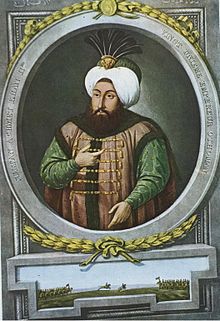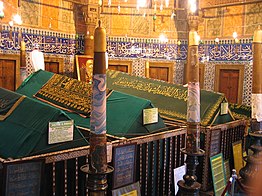| This article needs additional citations for verification. Please help improve this article by adding citations to reliable sources. Unsourced material may be challenged and removed. Find sources: "Ahmed II" – news · newspapers · books · scholar · JSTOR (August 2016) (Learn how and when to remove this message) |
| Ahmed II | |||||
|---|---|---|---|---|---|
| Ottoman Caliph Amir al-Mu'minin Custodian of the Two Holy Mosques | |||||
 | |||||
| Sultan of the Ottoman Empire (Padishah) | |||||
| Reign | 22 June 1691 – 6 February 1695 | ||||
| Predecessor | Suleiman II | ||||
| Successor | Mustafa II | ||||
| Born | 25 February 1643 or 1 August 1642 Constantinople, Ottoman Empire | ||||
| Died | 6 February 1695(1695-02-06) (aged 51) Edirne, Ottoman Empire | ||||
| Burial | Süleymaniye Mosque, Istanbul, Turkey | ||||
| Consort | Rabia Sultan Şayeste Hatun | ||||
| Issue | Şehzade Ibrahim Şehzade Selim Asiye Sultan Atike Sultan Hatice Sultan | ||||
| |||||
| Dynasty | Ottoman | ||||
| Father | Ibrahim | ||||
| Mother | Muazzez Sultan | ||||
| Religion | Sunni Islam | ||||
| Tughra |  | ||||
Ahmed II (Ottoman Turkish: احمد ثانی, romanized: Aḥmed-i sānī; Turkish: II. Ahmed; 25 February 1643 or 1 August 1642 – 6 February 1695) was the sultan of the Ottoman Empire from 1691 to 1695.
Early life
Ahmed II was born on 25 February 1643 or 1 August 1642, the son of Sultan Ibrahim and Muazzez Sultan. On 21 October 1649, Ahmed, along with his brothers Mehmed and Suleiman were circumcised. During the reigns of his older brothers, Ahmed was imprisoned in Kafes, and he stayed there almost 43 years.

Reign
| This section does not cite any sources. Please help improve this section by adding citations to reliable sources. Unsourced material may be challenged and removed. (October 2016) (Learn how and when to remove this message) |
During his reign, Ahmed II devoted most of his attention to the wars against the Habsburgs and related foreign policy, governmental and economic issues. Of these, the most important were the tax reforms and the introduction of the lifelong tax farm system (malikâne). Following the recovery of Belgrade under his predecessor, Suleiman II, the military frontier reached a rough stalemate on the Danube, with the Habsburgs no longer able to advance south of it, and the Ottomans attempting, ultimately unsuccessfully, to regain the initiative north of it.
Among the most important features of Ahmed's reign was his reliance on Köprülüzade Fazıl Mustafa Pasha. Following his accession to the throne, Ahmed II confirmed Fazıl Mustafa Pasha in his office as grand vizier. In office from 1689, Fazıl Mustafa Pasha was from the Köprülü family of grand viziers, and like most of his Köprülü predecessors in the same office, was an able administrator and military commander. Like his father Köprülü Mehmed Pasha (grand vizier, 1656–61) before him, Fazıl Mustafa Pasha ordered the removal and execution of dozens of corrupt state officials of the previous regime and replaced them with men loyal to himself. He overhauled the tax system by adjusting it to the capabilities of the taxpayers affected by the latest wars. He also reformed troop mobilization and increased the pool of conscripts available for the army by drafting tribesmen in the Balkans and Anatolia. In October 1690, Fazıl Mustafa Pasha recaptured Belgrade, a key fortress that commanded the confluence of the rivers Danube and Sava; in Ottoman hands since 1521, the fortress had been conquered by the Habsburgs in 1688.
Fazıl Mustafa Pasha's victory at Belgrade was a major military achievement that gave the Ottomans hope that the military debacles of the 1680s—which had led to the loss of Hungary and Transylvania, an Ottoman vassal principality ruled by pro-Istanbul Hungarian princes—could be reversed. However, the Ottoman success proved ephemeral. On 19 August 1691, Fazıl Mustafa Pasha suffered a devastating defeat at the Battle of Slankamen at the hands of Louis William, the Habsburg commander in chief in Hungary, nicknamed “Türkenlouis” (Louis the Turk) for his victories against the Ottomans. In the confrontation, recognized by contemporaries as “the bloodiest battle of the century,” the Ottomans suffered heavy losses: 20,000 men, including the grand vizier. With him, the sultan lost his most capable military commander and the last member of the Köprülü family, who for the previous half century had been instrumental in strengthening the Ottoman military.
Under Fazıl Mustafa Pasha's successors, the Ottomans suffered further defeats. In June 1692 the Habsburgs conquered Oradea, the seat of an Ottoman governor (beylerbeyi) since 1660. In 1694, they attempted to recapture Oradea, but to no avail. On 12 January 1695, they surrendered the fortress of Gyula, the center of an Ottoman sanjak (subprovince) since 1566. With the fall of Gyula, the only territory still in Ottoman hands in Hungary was to the east of the River Tisza and to the south of the river Maros, with its center at Timișoara. Three weeks later, on 6 February 1695, Ahmed II died in Edirne Palace.
Family
Consorts
Ahmed II had two known consorts:
- Rabia Sultan (died Eski Palace, Istanbul, 14 January 1712, buried in Suleiman I Mausoleum, Süleymaniye Mosque). Ahmed II's most beloved consort and the last haseki sultan of the Ottoman Empire;
- Şayeste Hatun (died in 1710). Second concubine of Ahmed II, perhaps mother of his other daughters.
Sons
Ahmed II had two sons:
- Şehzade Ibrahim (Edirne Palace, Edirne, 6 October 1692 – Topkapı Palace, Istanbul, 4 May 1714, buried in Mustafa I Mausoleum, Hagia Sophia), with Rabia Sultan, Selim's twin, became crown prince on 22 August 1703 until his death;
- Şehzade Selim (Edirne Palace, Edirne, 6 October 1692 – Edirne Palace, Edirne, 15 May 1693, buried in Sultan Mustafa Mausoleum, Hagia Sophia), with Rabia Sultan, Ibrahim's twin.
Daughters
Ahmed II had three daughters:
- Asiye Sultan (Edirne Palace, Edirne, 24 August 1694 – Eski Palace, Bayezid, Istanbul, 9 December 1695, buried in Suleiman I Mausoleum, Süleymaniye Mosque), with Rabia Sultan;
- Atike Sultan (born 21 October 1694), probably with Şayeste Hatun. Died in infancy.
- Hatice Sultan, probably with Şayeste Hatun. Died in infancy.
In addition to his daughters, Ahmed II was deeply attached to his niece Ümmügülsüm Sultan, daughter of his half-brother Mehmed IV, so much so that he treated her as if she were his own daughter.
References
Citations
- Mantran 2012, first date according to Naima, second date to Raşid.
- Sakaoğlu 2015, p. 271.
- Uluçay 1980, p. 114.
- Sakaoğlu 2015, p. 390.
- ^ Mehmed Agha 2012, pp. 1466–67, 1483–84, 1580.
- Uluçay 1980, p. 115.
- ^ Uluçay 1980, pp. 114–115.
- Uluçay 2011, p. 111.
- Uluçay 1992, p. 111.
Sources
- Mantran, R. (24 April 2012). Bearman, P.; Bianquis, Th.; Bosworth, C.E.; van Donzel, E.; Heinrichs, W.P. (eds.). "Aḥmad II". Encyclopaedia of Islam, Second Edition. doi:10.1163/1573-3912_islam_sim_0389.
- Mehmed Agha, Silahdar Findiklili (2012). ZEYL-İ FEZLEKE (1065-22 Ca.1106 / 1654-7 Şubat 1695). pp. 1466–67, 1483–84, 1580.
- Sakaoğlu, Necdet (2015). Bu mülkün kadın sultanları : valide sultanlar, hatunlar, hasekiler, kadinefendiler, sultanefendiler [The Female Sultans of This Property : Valide Sultans, Hatuns, Hasekis, Ladies and Gentlemen]. İstanbul: Alfa publications. ISBN 9786051710792.
- Uluçay, M. Çağatay (1980). Padişahların kadınları ve kızları (in Turkish). Türk Tarih Kurumu Basımevi. Retrieved 7 October 2020.
- Uluçay, M. Çağatay (1992). Padişahların Kadınları ve Kızları. Ankara: Türk Tarih Kurumu Basımevı. ISBN 978-9-751-60461-3.
- Uluçay, Mustafa Çağatay (2011). Padişahların kadınları ve kızları. Ankara: Ötüken.
Further reading
- Finkel, Caroline (2005). Osman's Dream: The Story of the Ottoman Empire, 1300-1923. New York: Basic Books. ISBN 978-0-465-02396-7.
- Michael Hochendlinger, Austria's Wars of Emergence: War, State and Society in the Habsburg Monarchy, 1683–1797 (London: Longman, 2003), 157–64.
External links
[REDACTED] Media related to Ahmed II at Wikimedia Commons
[REDACTED] Works by or about Ahmed II at Wikisource
| Ahmed II House of OsmanBorn: 25 February 1643 Died: 6 February 1695 | ||
| Regnal titles | ||
|---|---|---|
| Preceded bySuleiman II | Sultan of the Ottoman Empire 22 June 1691 – 6 February 1695 |
Succeeded byMustafa II |
| Sunni Islam titles | ||
| Preceded bySuleiman II | Caliph of the Ottoman Caliphate 22 June 1691 – 6 February 1695 |
Succeeded byMustafa II |
| 1st generation |  | |
|---|---|---|
| 2nd generation | ||
| 3rd generation | ||
| 4th generation | ||
| 5th generation | ||
| 6th generation | ||
| 7th generation | ||
| 8th generation | ||
| 9th generation | ||
| 10th generation | ||
| 11th generation | ||
| 12th generation | ||
| 13th generation | ||
| 14th generation | ||
| 15th generation | ||
| 16th generation | ||
| 17th generation | ||
| 18th generation | ||
| 19th generation | ||
| 20th generation | ||
| 21st generation |
| |
| 22nd generation | ||
| 23rd generation | ||